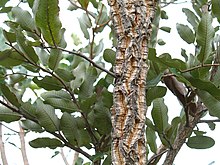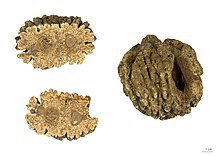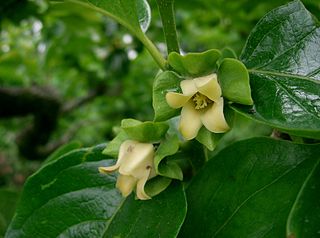
Diospyros is a genus of over 700 species of deciduous and evergreen trees and shrubs. The majority are native to the tropics, with only a few species extending into temperate regions. Individual species valued for their hard, heavy, dark timber, are commonly known as ebony trees, while others are valued for their fruit and known as persimmon trees. Some are useful as ornamentals and many are of local ecological importance. Species of this genus are generally dioecious, with separate male and female plants.

Endiandra is a genus of about 126 species of plants, mainly trees, in the laurel family Lauraceae. They are commonly called "walnut" despite not being related to the Northern Hemisphere walnuts which are in the family Juglandaceae.

Chrysobalanaceae is a family of flowering plants, consisting of trees and shrubs in 27 genera and about 700 species of pantropical distribution with a centre of diversity in the Amazon. Some of the species contain silica in their bodies for rigidity and so the mesophyll often has sclerenchymatous idioblasts. The widespread species Chrysobalanus icaco produces a plum-like fruit and the plant is commonly known as the coco plum.
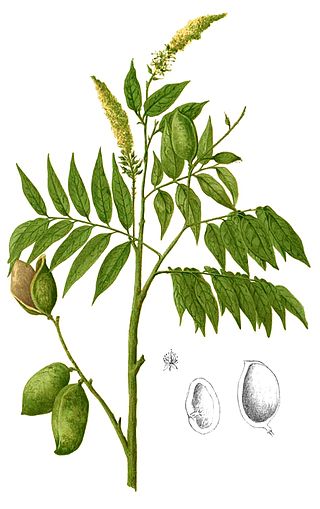
Crudia is a genus of plants in the family Fabaceae.
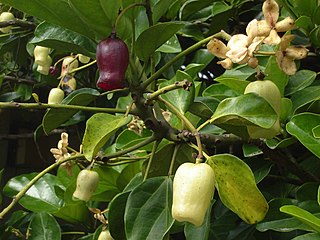
Atuna is a genus of plants in the family Chrysobalanaceae described as a genus in 1838. It is native to the Indian Subcontinent, Southeast Asia, and various islands of the western Pacific.

Licania is a genus of over 100 species of trees and shrubs in the family Chrysobalanaceae. Species are found naturally occurring in neotropical forests from southern Mexico to Brazil and the Lesser Antilles. Due to increased deforestation and loss of habitat, several species have declined, some markedly so, and L. caldasiana from Colombia appears to have gone extinct in recent years. Many species are either rare or restricted in distribution and therefore potentially threatened with future extinction. In 2016, a new circumscription of Licania was outlined, with over 100 species being placed in other genera such as Moquilea, Leptobalanus, Hymenopus, Microdesmia, Parinariopsis, Geobalanus and Cordillera.

Maranthes is a genus of plant in the family Chrysobalanaceae described as a genus in 1825.
Parinari argenteo-sericea is a tree of Borneo in the family Chrysobalanaceae. The specific epithet argenteo-sericea is from the Latin meaning "silvery silky", referring to the pubescence of the inflorescence and flowers.

Renealmia is a plant genus in the family Zingiberaceae. Its members are native to tropical Africa and tropical America. In Peru, fruits and tubers are sources of indigenous dyes. and indigenous medical treatments for leishmania and malaria In Colombia, it is used to treat snakebite. Bracts and leaves can serve as phytotelmata, retaining small quantities of water that offer habitat for other organisms.
Parinari canarioides is a tree in the family Chrysobalanaceae. The specific epithet canarioides is for the species' resemblance to the genus Canarium.
The Cucaracha Formation (Tca) is a geologic formation in Panama. It preserves vertebrate and plant fossils dating back to the Neogene period; Early to Middle Miocene epochs (Hemingfordian). Fossils of the crocodylian Centenariosuchus, the turtle Rhinoclemmys panamaensis and the artiodactyl Paratoceras have been found in the formation.
Angelesia is a genus of flowering plants belonging to the family Chrysobalanaceae.
Gaulettia is a genus of flowering plants belonging to the family Chrysobalanaceae.
Leptobalanus is a genus of flowering plants belonging to the family Chrysobalanaceae.
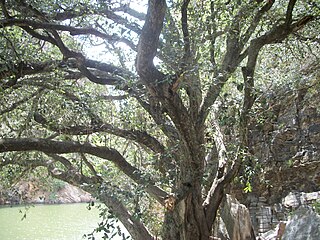
Microdesmia is a genus of flowering plants belonging to the family Chrysobalanaceae.
Moquilea is a genus of flowering plants belonging to the family Chrysobalanaceae.
Atuna excelsa is a species of flowering plant in the family Chrysobalanaceae, native to Thailand to the western Pacific.
Hymenopus is a genus of plants in the family Chrysobalanaceae, native to Central and South America.
